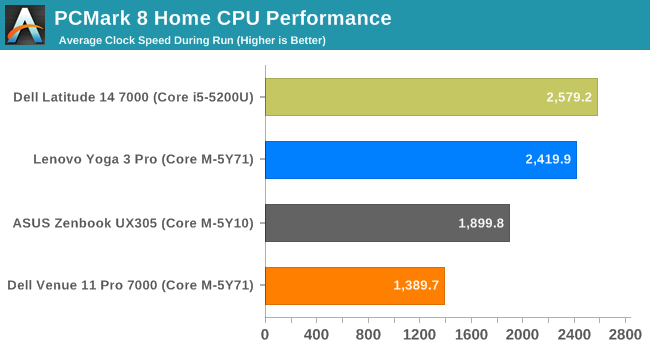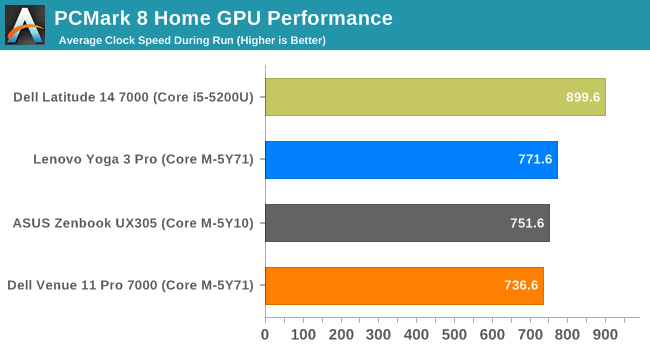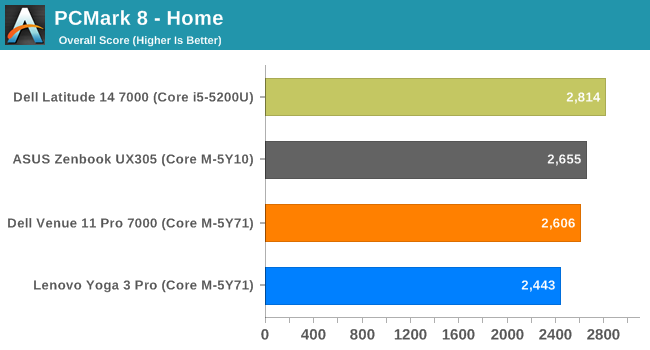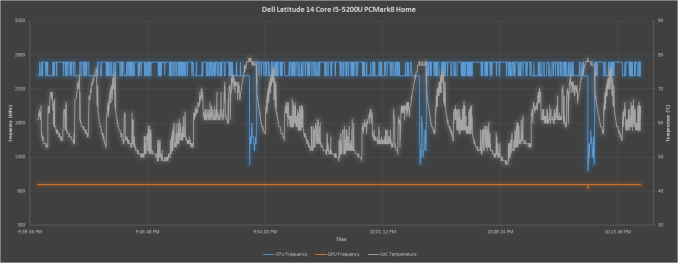Analyzing Intel Core M Performance: How 5Y10 can beat 5Y71 & the OEMs' Dilemma
by Brett Howse & Ian Cutress on April 8, 2015 8:00 AM ESTPCMark 8 Home Results
PCMark 8 Home is a much different workload than Cinebench. Cinebench thrives on sustained performance over the duration of the workload, with the CPU utilization staying around 100% for the duration. While an important metric, most people do not use their computers like that in their day to day lives, so Futuremark has crafted the PCMark suite to perform tasks which are more akin to what the average person will do in a day. Home includes workloads for web browsing, writing, gaming, photo editing, and video chat, and the nature of these loads mean that there is a lot more burst performance needed, so the race to sleep mentality of the Core M can be more effective in this scenario.
The burst nature of this benchmark is apparent just looking at the Core i5. No longer is the CPU frequency consistent across the board, and the temperatures ramp up and down as the work is performed and finished. Even more pronounced is the Dell tablet, which spikes up and down from its maximum temperature, but at the same time ramping clock speeds up quite high as well. The incredible cooling of the ASUS UX305 passive solution makes a big difference here, with the UX305 being able to maintain almost its maximum frequency for the duration of this benchmark. The Yoga 3 Pro really shines here though, with it maintaining quite high speeds for almost the entire duration of the benchmark.

Average CPU frequencies on the other hand show an unexpected disparity between the results we saw above and what the averages end up being. It's the cool Yoga 3 Pro that holds the highest average clockspeeds, followed by the UX305, and finally bringing up the rear is the Venure 11 Pro 7000.

The GPU averages for the three Core M devices are very similar overall, although none are at their maximum. Only the 15 watt Core i5 can maintain its maximum GPU frequency for the duration of this test. As we will see later, GPUs can draw a lot of power.

Moving on to temperature, with the burst nature of this benchmark, all of the devices have a reasonable time to cool off between workloads. The ASUS shows its amazing cooling capabilities again, with a significantly lower temperature than even both of the active cooled devices, but none of them are too close to their maximum allowed temperature over the duration.

Looking at the end result of this benchmark kind of throws everything we have seen in the above graphs on its head. The Yoga 3 Pro, despite sustaining a CPU frequency higher than all of the other Core M devices in this test, ends up scoring the worst, however the overall result by the Yoga 3 Pro is disadvantaged in this benchmark by the gaming test, due to the high resolution display on the Yoga 3 Pro. This is very similar to the results seen in the Dell XPS 13 review, where the QHD+ model only scored 2691 and the FHD model scored 3042 with the same processor. However the ASUS UX305 beats the other Core M devices, although it does so with a much lower resolution display than the Yoga 3 Pro which would certainly beat it otherwise.














110 Comments
View All Comments
xilience - Wednesday, April 8, 2015 - link
Minor issue with one of the graphs. PCMark8 Home graph, the temperature scales are different for each device, whereas they look to be the same for all other tests. The numbers are correct, but when quickly comparing graphs it can be confusing to read. THANKS for this great article, it gives a lot of insight into mobile hardware design.digiguy - Wednesday, April 8, 2015 - link
Very interesting article. Core M makes sense (contrary to what some people say in the comments) for those that have the money and want a totally silent device.Having said that, some ultrabooks and core tablets (like my 35W TDP Asus ultrabook or my surface pro 3 i3) are extremely silent, with the fan kicking in only while gaming, which in my opinion is a small concession in exchange for sustained performance (zero throttling in either of the 2 devices).
Also the race to the thinnest device is probably questionable, especially for laptops. Making a smaller device with a bigger screen like Dell did is a great idea, making it thinner and thinner doesn't add much and subtracts performance or adds heat.
What a pity you didn't add the new Macbook to the comparison (probably not available yet). Hope you will do an updated version with it. It will also allow to see how 5y71 performs in a laptop, rather than in a convertible/tablet.
TEAMSWITCHER - Wednesday, April 8, 2015 - link
The problem with just making devices thicker and adding fans is that it compromises portability for only a little in extra performance.For nearly a decade, I carried around a 15" PowerBook or MacBook Pro. Good machines but only mid-range graphic performance. Recently, I slimmed down to an 11" MacBook Air, and I will never...ever...go back to lugging around a larger device.
I also have a desktop Windows Workstation for performance oriented work. It's much faster than any laptop you can buy. Using Drop Box and One Drive I keep files synced between the two machines, and can just hop-up from my Workstation, grab my Mac Book, and hit the door.
Thankfully, my computer budget is large enough to afford a Workstation and a Mac Book - it's actually a necessity for cross-platform developers. I get extreme performance from my workstation and extreme portability from my Mac Book. I don't have to live with compromises, I just have to switch devices.
Refuge - Wednesday, April 8, 2015 - link
I'm all for small form factors and portability, I notice the difference between my 15 inch laptop and my girlfriends 10 inch convertable. It is substantial, but I don't feel that going thinner is the way anymore.The increase in portability I feel personally is purely from the decrease in screen size which naturally lowers the dimensions and weight of the device considerably, but some of these are getting so thin that they are actually uncomfortable, I don't want to hold a blade, or a brick, give me a thing (but not a blade like thin) laptop with a 11 inch screen for on the go work, make it cool, quiet, and perform, and make it like an inch thick, then knock it from $1,000 to $500. I'll buy it everytime.
I feel the same way about phones, I don't want my next one to be thinner, or have a bigger screen.
5 inches fits my hand perfectly, I don't work or game on it. I use it to pass time reading Anandtech or communicating with the world.
I game at home on my SFF that I can easily take to a lan party, or I work on my portable but not paper thin laptop.
I'm happy in all regards honestly. But I suppose this just comes down to personal preference much like how nice peripherals are comes down to taste in the end barring any insufferable design choices.
wallysb01 - Thursday, April 9, 2015 - link
"5 inches fits my hand perfectly"That's what she said.
digiguy - Wednesday, April 8, 2015 - link
"The problem with just making devices thicker and adding fans is that it compromises portability for only a little in extra performance."I think it's actually the contrary, if we talk about laptops/ultrabooks. There can be a big increase in performance for very little increase in thinkness and noise. My ultrabook has a 35w mobile second generation i7 that still performs better than any 4th gen i7 ULV CPUs, let alone Core M... And still it's thin, light and with 8 hours battery life. It is so silent that the fan won't kick in even when I do an OCR of a 10 page file...
For tablets it's different, but still, my SP3 (i3) is thin and has a fan, that never kicks in... Only while gaming, and I am actually happy it does, cause this way there is no throttling.... I would want it to be fanless.... (as I wouldn't like the fan to kick in more often like in the i5 and especially i7 models).
digiguy - Thursday, April 9, 2015 - link
Sorry in the last sentence I meant "I wouldN'T want it to be fanless"Krysto - Wednesday, April 8, 2015 - link
> Atom sits at the lower price band ($50-$100 per chip), typically in a dual or quad core arrangement without hyperthreading and uses ‘modules’ of two discrete cores sharing an L2 cache.More like $107-$161 going by your previous "Braswell" article.
What I'd like to see is how does the $281 Core-M compare to the ~$100 Haswell Celeron from the previous generation in terms of performance.
smilingcrow - Wednesday, April 8, 2015 - link
Brawell is a different market sector though so pricing may not be comparable.kyuu - Wednesday, April 8, 2015 - link
He was referring to mobile atoms (the ones that compare directly to Core M). Braswell is a different market segment, as smilingcrow said.